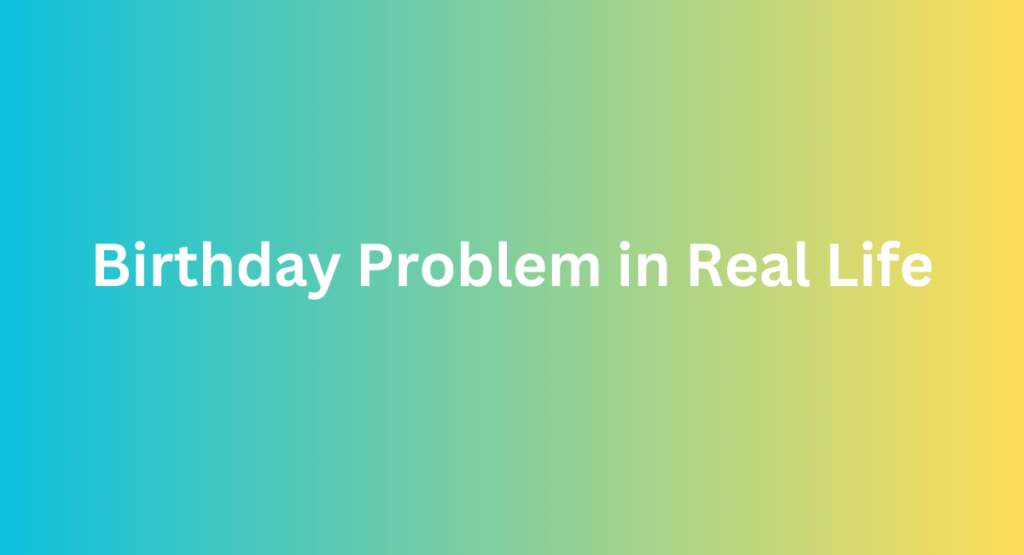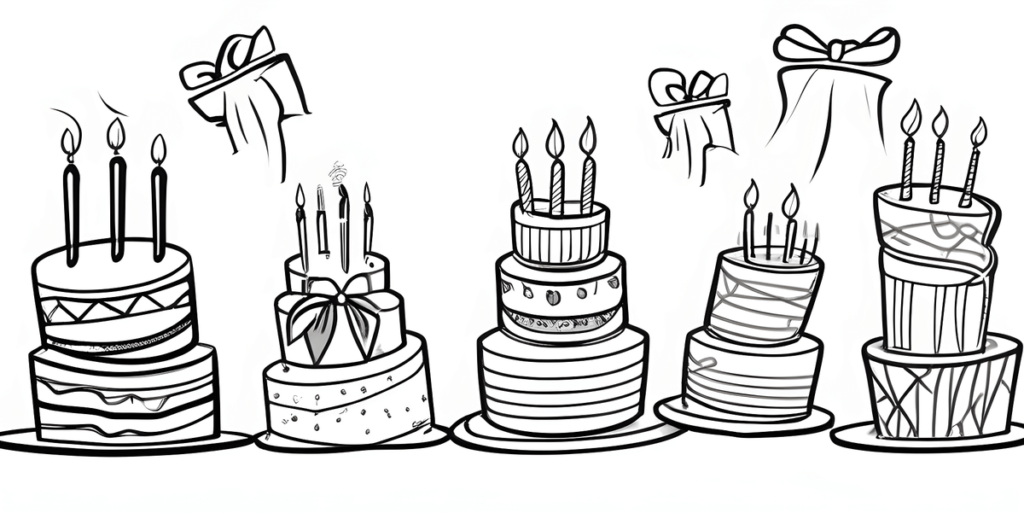The Birthday Problem in real life refers to the likelihood of two people sharing the same birthday. In a group of just 23 people, there is a 50% chance that two of them will share the same birthday.
This may seem counterintuitive, but it’s a fascinating phenomenon with practical implications. When people consider the probability of two individuals sharing a birthday, they often underestimate how quickly the likelihood adds up with more people involved. This concept has applications in fields such as cryptography, where understanding the probability of certain events occurring is crucial.
Additionally, it’s a fun way to introduce the concept of probability and statistics in a relatable and engaging manner. By exploring the Birthday Problem in real-life scenarios, we can gain a deeper appreciation for the way probabilities work in everyday situations.
Exploring Birthday Problem In Real Life
Humans often find ourselves fascinated by patterns and probabilities that occur in everyday situations. One such intriguing phenomenon is the Birthday Problem, which has implications in various aspects of our lives. In this blog post, we will delve into the real-life exploration of the Birthday Problem and how it affects social gatherings, scheduling, and planning.
Statistics In Social Gatherings
When attending a social gathering, have you ever wondered how likely it is for two or more people to share the same birthday? This scenario may seem unlikely, but the Birthday Problem sheds light on the surprising probabilities in such situations.
- Statistically, in a group of just 23 people, there is already a 50% chance that at least two individuals will share the same birthday.
- With only 57 people, the probability rises to a staggering 99%.
These statistics highlight the counterintuitive nature of the Birthday Problem and demonstrate how patterns emerge even in seemingly unrelated scenarios.
Implications In Scheduling And Planning
The insights gained from the Birthday Problem extend beyond social gatherings and can be applied in various practical situations, especially in scheduling and planning.
Consider a scenario where you are tasked with scheduling appointments for a group of people:
| Number of People | Probability of Shared Birthday |
|---|---|
| 10 | 12.05% |
| 20 | 41.09% |
| 30 | 70.63% |
This table showcases the increasing likelihood of shared birthdays as the number of people increases. Understanding these probabilities can help you optimize appointment scheduling to avoid potential conflicts.
Furthermore, the Birthday Problem can guide event planners in allocating resources, such as booking venues or planning activities, while considering the chances of shared birthdays within the attendees.
The exploration of the Birthday Problem in real-life situations unveils intriguing connections between statistics and our everyday experiences. By understanding these probabilities, we can make more informed decisions in various aspects of our lives, from social gatherings to scheduling and planning.
Mitigating Challenges
The birthday problem, a famous probability puzzle, arises in real-life event planning when the likelihood of two or more people sharing the same birthday needs to be considered. Mitigating the challenges associated with this phenomenon is essential to ensure successful event management.
Utilizing Technology
In today’s digital age, utilizing technology can be instrumental in addressing the birthday problem. With the help of advanced event management software and data analytics, event planners can efficiently track and manage guest birthdays, thereby reducing the probability of overlaps.
Strategies For Event Planners
- Implement strategic seating arrangements to minimize the chances of individuals with the same birthdays being seated together.
- Utilize targeted communication to gather accurate information about attendees’ birthdays, ensuring meticulous planning.
- Employ innovative themed events based on birth months rather than specific dates, reducing the probability of birthday clashes.
Educational Applications
When it comes to educational applications, the Birthday Problem presents an excellent opportunity for students to explore and comprehend probability in a practical context. Teaching probability with the Birthday Problem and engaging classroom activities can enhance students’ critical thinking and problem-solving skills while making the learning experience enjoyable and relatable.
Teaching Probability With Birthday Problem
The Birthday Problem provides a real-life scenario that enables educators to introduce students to the concept of probability in a tangible and engaging manner. By using this problem as a teaching tool, teachers can foster students’ understanding of the fundamental principles of probability and statistical reasoning, laying a strong foundation for their future mathematical studies.
Engaging Classroom Activities
Implementing engaging classroom activities related to the Birthday Problem can captivate students’ interest and stimulate active participation. Teachers can facilitate discussions and group activities that prompt students to analyze and interpret the probability of shared birthdays within different group sizes. Additionally, organizing interactive experiments and simulations can help students visualize the concept of probability in a memorable way.
Psychological Insights
Explore the intriguing concept of the Birthday Problem in real-life scenarios through psychological insights. Gain a deeper understanding of how probability theory applies to everyday situations and its impact on decision-making processes. Delve into the complexities of human behavior and probability in a thought-provoking exploration.
Our perception of the world is shaped by our experiences and the information we receive. When it comes to coincidental birthdays, our minds tend to make various associations and judgments that can impact our thoughts and actions. Let’s explore some psychological insights into the phenomenon.
Impact Of Coincidental Birthdays On Perception
Coincidental birthdays, where two or more individuals share the same birth date, can have a profound effect on how we perceive others. The mere knowledge of this similarity often leads us to make assumptions about these individuals, sometimes without even realizing it.
These assumptions can range from shared personality traits to common life experiences, creating a sense of familiarity and connection. However, it’s important to remember that shared birthdays do not guarantee these assumptions to be true.
Each person is unique, and similarities in birth dates do not necessarily translate to similarities in all aspects of life. Being aware of this bias can help us approach such situations with an open mind and avoid the potential pitfalls of stereotype-based thinking. Psychological Theories at Play
Impact Of Coincidental Birthdays On Perception
One psychological theory that explains the impact of coincidental birthdays on perception is the “halo effect.” This cognitive bias occurs when our overall judgment of a person is influenced by a single positive trait or characteristic.
In the context of shared birthdays, knowing that someone has the same birth date may lead us to perceive them more positively and attribute other desirable qualities to them. It’s fascinating how such a seemingly trivial similarity can shape our impressions of others.
However, it’s essential to recognize that the halo effect can also lead to unrealistic expectations or inflated perceptions of individuals solely based on their coincidental birthdays. Therefore, it’s crucial to maintain objectivity and consider a person’s individual merits beyond the date they were born.
Another psychological theory at play is the “confirmation bias.” This bias involves seeking and interpreting information that confirms our pre-existing beliefs or assumptions while disregarding contradictory evidence. In the case of coincidental birthdays, we may actively seek out similarities between people who share the same birth date, focusing on aspects that reinforce our initial perception.
While confirmation bias can provide a sense of comfort and validation, it also limits our perspective and hinders our ability to see individuals as distinct entities. By being aware of this bias, we can strive to approach relationships and encounters with an open mind, allowing for a more accurate understanding of others beyond the coincidence of birthdays.
In conclusion, the psychological insights into coincidental birthdays remind us of the potential impact of assumptions and biases on our interactions and perceptions. By recognizing these influences and striving for objectivity, we can foster deeper connections and appreciate the uniqueness of individuals beyond the date they were born.
So next time you come across someone with the same birthday, embrace the opportunity to discover the person they are rather than relying solely on assumptions based on coincidence.
Cultural Perspectives
Birthday celebrations traditions vary across different cultures globally.
birthday Celebrations Traditions
Customs such as birthday cakes and parties are widespread.
Some cultures emphasize elaborate feasts and meaningful gifts.
Certain communities prioritize family gatherings and special rituals.
historical Significance Of Birthdays
Celebrating birthdays dates back to ancient civilizations.
In Roman times, birthdays were celebrated with feasts and offerings.
They were seen as occasions to honor gods and mark milestones.
Frequently Asked Questions Of Birthday Problem In Real Life
What Is Known As The Birthday Problem?
The birthday problem refers to the probability of two people sharing the same birthday in a group. It’s surprising that with just 23 people, the chances of a shared birthday are over 50%.
What Is The Famous Birthday Problem?
The famous birthday problem explores the probability that people in a group share the same birthday. It’s a well-known probability puzzle.
What Is The Birthdate Problem?
Birthdate problem refers to issues related to incorrect or missing birthdate information. It can lead to identity verification problems and affect various services. Regularly updating and verifying birthdate details is crucial to avoid potential issues.
What Is The Birthday Celebration Problem?
The birthday celebration problem refers to the mathematical puzzle of determining the minimum number of people in a group for the probability of at least two individuals sharing the same birthday to exceed 50%.
Conclusion
The birthday problem may seem like a mere mathematical puzzle, but its implications extend to our everyday lives. As we celebrate birthdays and gather in groups, we often overlook the probability of shared birth dates. This phenomenon highlights the power of statistics and the unexpected connections that exist among individuals.
By understanding this problem, we can appreciate the fascinating and unpredictable nature of our own experiences and relationships. So, next time you blow out your birthday candles, remember the hidden connections that may be closer than you think.



